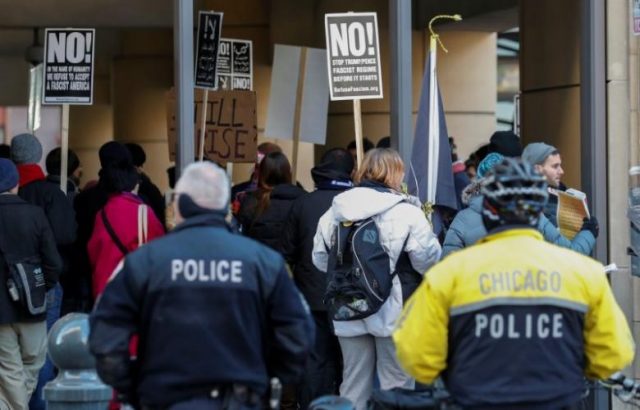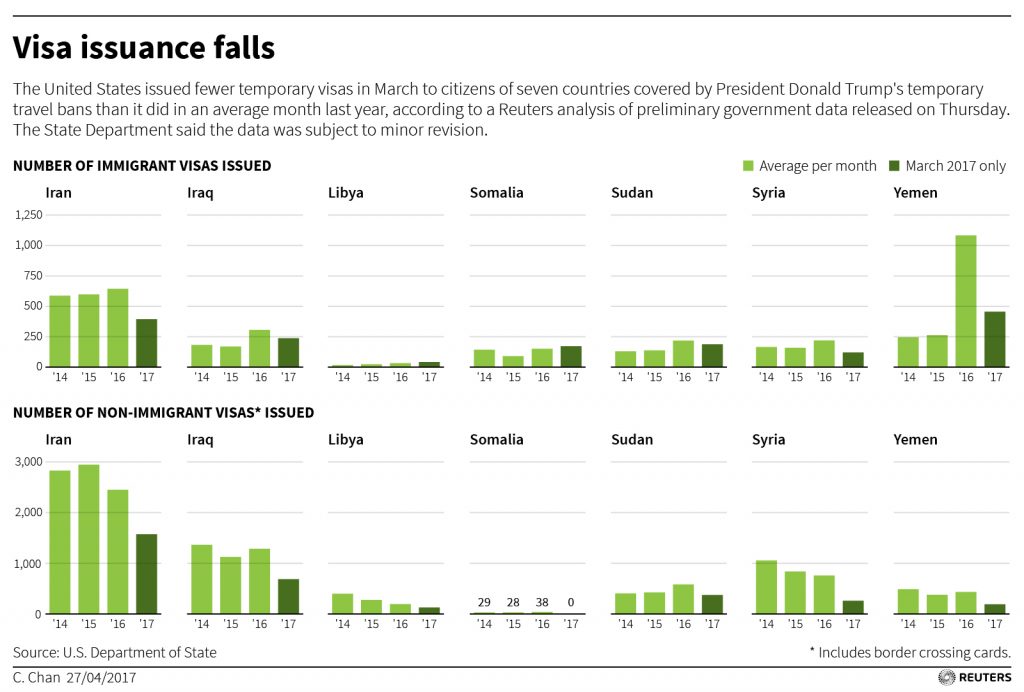
WASHINGTON — The United States issued about 40 percent fewer temporary visas in March to citizens of seven countries covered by President Donald Trump’s temporary travel bans than it did in an average month last year, according to a Reuters analysis of preliminary government data released on Thursday.
At the same time, the data showed that the total of US non-immigrant visas issued to people from all countries was up by nearly 5 percent in March compared to the 2016 monthly average.
Citizens of the seven Muslim-majority nations under the bans — Iran, Iraq, Libya, Somalia, Sudan, Syria and Yemen — received about 3,200 non-immigrant visas in March 2017, compared to about 5,700 on average per month during the 2016 fiscal year and more than 6,000 on average per month in 2015 and 2014. Trump’s travel bans were later blocked by the courts.

The State Department released the data to comply with a directive from Trump asking it to publish monthly breakdowns of the number of visas issued around the world.
The department did not release data on the total number of all types of visa applications, so it is unclear whether the lower number of temporary visas for citizens of the seven countries is because of a higher rate of rejections or other factors, such as fewer applicants or slower processing times.
A State Department official noted that “visa demand is cyclical, not uniform throughout the year, and affected by various factors at the local and international level. Visa issuance numbers tend to increase during peak travel seasons, such as during the summer and the winter holidays.”
The White House did not immediately respond to a request for comment.
March is neither a busy nor slow time for temporary visa issuances to people from the seven countries, several immigration lawyers said. Therefore, the significant drops are notable, they said.
The data is preliminary and numbers could be subject to minor revision, the State Department said.
Previously, such data was only available in aggregate by fiscal year, and the department declined to break out March visa data from previous years.
Nevertheless, some immigration attorneys said the numbers released on Thursday provide a glimpse into how Trump’s policies are affecting visa decisions.
“Either there are many fewer people applying because they believe they will be denied, or a much higher rate of denials is already happening even though the executive orders have been blocked,” said William Stock, president of the American Immigration Lawyers Association.
Executive orders
Trump, who has said the travel bans were intended to make Americans safer from attacks by terrorists, signed an executive order on January 27 barring people from the seven countries from entering the United States for 90 days.
The order was blocked by federal courts and the Trump administration replaced it with a revised, narrower travel ban effective March 16 which dropped Iraq from the list. Courts have also halted parts of the second order.
The number of non-immigrant visas issued to Iranians dropped to 1,572 in March from 2,450 per month on average in 2016 according to the data. Iraqis received 684 such visas in March, compared to nearly twice that number per month on average in 2016, the data showed.
Iranians also received fewer immigrant visas, which are granted to family members of US citizens or those with jobs in the United States, than the average in previous years — 393 received immigrant visas in March, compared to 644 on average per month in 2016 and nearly 600 on average per month in 2015 and 2014.
Although visitor visas were down across the board for the seven targeted countries, two of them saw the number of immigrant visas issued tick up slightly. Forty-one Libyans received immigrant visas in March, compared to 32 per month on average in 2016. Somalians received 171 visas in March compared to 150 on average in 2016.
Immigration lawyers said that although the travel bans have been halted by courts for now, the administration’s vow to put stricter controls on immigration is likely to have changed how US consulates evaluate visa applicants.
Stephen Pattison, a former State Department consular official now working as an immigration attorney, said consulates “are going to probably err more on the side of denying some people that they’d be on the fence about.”
Anecdotally, several US-based lawyers with Iranian clients say their visa applications are taking longer to process and are being rejected more often since Trump took office on January 20.
They cite shortages of interview appointments for Iranians, interviews canceled at the last minute and longer “administrative processing” periods than they are accustomed to.
“If you can’t get an interview, you can’t get a visa,” said Babak Yousefzadeh, a San Francisco-based attorney and member of the board of directors of the Iranian American Bar Association.
Some Iranians have decided that for now, it is not worth it to risk the expense and time of making US visa applications, said Kiyanoush Razaghi, a Maryland-based immigration attorney.
In addition to paying a standard $160 visa application fee, Iranians must typically travel to Turkey, Armenia or the United Arab Emirates for their interviews, since there is no US diplomatic presence in Iran.
“That’s a fundamental change that I am seeing, at least in the community and among the clients that I have,” Razaghi said. “They have a general feeling that now is not a good time to apply for a visa.”









